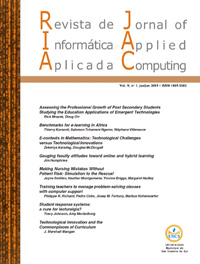Assessing the Professional Growth of Post Secondary Students Studying the Education Applications of Emergent Technologies
DOI:
https://doi.org/10.13037/ria.vol5n1.365Keywords:
Professional Development, Collaborative Self-Reflection, Emergent TechnologiesAbstract
The "Level of Use of an Innovation" (LoU) and "Stages of Concern" (SoC) assessments are key components of the Concerns-Based Adoption Model (CBAM). These tools can provide a clear articulation and characterization of the level of adoption of an organizational innovation in educational technology. An adaptation of the LoU was used to assess changes in understanding of and competence with educational technologies by participants in a graduate level course focused on the use of emergent technologies in professional development. The instrument reflected the criteria framework of the original LoU assessment tool, but was adapted to utilize a specifically structured self report scale of the "level of use" index to promote collaborative self-reflection. Growth in knowledge of, and confidence with, specific emergent technologies is clearly indicated by the results, thus supporting the use of collaborative reflection and assessment of the professional development process to foster professional growth.Downloads
References
ADEY, P. (1995). The effects of a staff development program: The relationship between the level of use of innovative science curriculum activities and student achievement. ERIC Research Report. ED 383567
BAILEY, D. & PALSHA, S. (1992). Qualities of the stages of concern questionnaire and implications for educational innovations. Journal of Educational Computing Research, 85(4), 226-232
DUFOUR, R., & EAKER, R. (1998). Professional learning communities at work: Best practices for enhancing student achievement. Bloomington, IN. National Educational Service
GERSHNER, V., SNIDER, S., & SHARLA, L. (2001). Integrating the use of internet as an instructional tool: Examining the process of change. Journal of Educational Computing Research, (25(3), 283-300
GRISWOLD, P. (1993). Total quality schools implementation evaluation: A concerns-based approach. ERIC Research Report. ED 385007
GUSKEY, T. (2005). Taking a second look at accountability. Journal of Staff Development, 26(1), 10-18
HALL, G. & HORD, S. (1987). Change in schools: Facilitating the process. Albany, NY. State University of New York
HALL, G., LOUCKS, S., RUTHERFORD, W. & NEWLOVE, B. (1975). Levels of use of the innovation: A framework for analyzing innovation adoption. Journal of Teacher Education, 26(1), 52-56
HORD, S., RUTHERFORD, W., HULING-AUSTIN, L. & HALL, G. (1987). Taking charge of change. Alexandria, VA. Association for Supervision and Curriculum Development
NATIONAL STAFF DEVELOPMENT COUNCIL. (2003). Moving NSDC's staff development standards into practice: Innovation configurations. Oxford, OH: Author
NEUMAN, W. (1997). Social research methods: Qualitative and quantitative approaches (3rd ed.). Needhan Heights, MA: Allyn and Bacon
NEWHOUSE, C. (2001). "Applying the concerns-based adoption model to research on computers in classrooms. Journal of Research on Computing in Education 33(5), 1-21
WENGER, E. (1998). Communities of practice: Learning, meaning, and identity. New York NY. Cambridge University Press
Downloads
Published
Issue
Section
License
Copyright (c) 2010 Rick Mrazek, Doug Orr

This work is licensed under a Creative Commons Attribution-NonCommercial-ShareAlike 4.0 International License.
Os autores que publicam trabalhos na RIA estão de acordo com os seguintes termos:
- Autores mantêm seus direitos autorais e concedem à RIA o direito à primeira publicação. Admite-se o compartilhamento do referido trabalho, desde que seja reconhecida sua autoria e publicação inicial nesta revista.
- Autores podem fechar contratos adicionais separadamente, para distribuição não exclusiva da versão do trabalho publicado na RIA, com reconhecimento de sua autoria e publicação inicial nesta revista.
- Autores podem publicar e distribuir seu trabalho online, antes ou durante o processo editorial.


